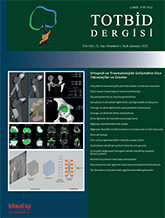
Knee joints are the most affected areas by these health problems. Knee pathologies are diseases that cause structural disorders and are among the complaints of almost four million individuals in Turkey alone. Tissues in patients can be detected with different segmentation techniques, but detection of pathologies in the knee complicates the segmentation process due to their narrowness. Although quantitative magnetic resonance (MR) imaging methods are used to identify pathologies, the application of these methods have difficulties in practice, it takes long time, is not automatic and has excessive workload. The increase in the success rate of the automatic segmentation method with the advances in deep learning and image processing has paved the way for more practical use of this method. The three dimensional segmentation method contributes significantly to the structuring of the treatment of degenerations by providing the visualization of pathologies. With this method, the disadvantages of semi-automatic and manual segmentation and the different interpretation possibilities of the evaluators are eliminated. Artificial intelligence programs are needed, which can be considered as a whole pathology of knee.